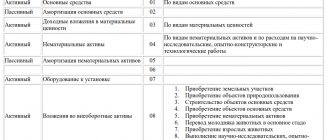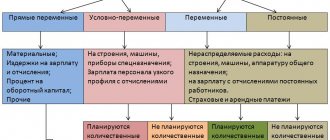Definition of the term "accounting"
Accounting is an orderly system for collecting, registering and summarizing information in monetary terms about the property, obligations of an organization and their movement through continuous, continuous and documentary accounting of all business transactions.
Accounting in accordance with the law on accounting can be carried out by: the chief accountant hired by the enterprise under an employment contract, the general director in the absence of an accountant, an accountant who is not the chief accountant, or a third-party organization (accounting support).
In the event that, in accordance with the terms of the agreement (contract), the foreign party is the first to fulfill its obligations, the Russian organization (unless otherwise specified in the agreement) does not become the owner of this product and, therefore, cannot put it on its balance sheet.
Only after the shipment of his goods, the Russian participant in the barter transaction accepts the imported material assets on the balance sheet and at the same time reflects the sale in the accounting records by making an entry in the accounting records [p.339] Lozinsky A.I. Course on the theory of balance sheet accounting. - M., 1938. [p.360] Lozinsky A.I. On the history of the development of accounting (balance sheet) accounting. - Saratov, 1939. [p.360]
The first quarter of the 20th century. Sievers's view became generally accepted, but by 1929 the Slavophile term accounting was decisively replaced by the German word accounting. The great turning point again presupposed the extermination of now national terminology. Several attempts were made to introduce some new words, and most often they mentioned (under the influence of A.P. Rudanovsky, I.A. Koshkin and Ya.M. Galperin) balance sheet or operational balance sheet accounting. [p.10]
From all accounts, when synthesized, a balance occurs, and from the balance all accounts flow. This is not just a paradox of the accounting procedure, it is its dialectic. And it is no coincidence that for many years it was the balance sheet that was and continues to be considered the defining main reporting form. As if expressing this approach, almost all Soviet authors (from 1929 to 1939), instead of the traditional phrase accounting, tried to speak and write balance sheet accounting. This emphasized the decisive role of the balance sheet in accounting. [p.401]
Rudanovsky A.P. The theory of balance sheet accounting. Valuation as the purpose of balance sheet accounting. Number system. - M., 1928. [p.235]
Rudanovsky A.P. Criticism of various accounting systems from the point of view of the theory of balance sheet accounting // Vestnik I.G.B.E. - 1928. - No. 12 1929. - No. 1, 3. [p.669]
Rudanovsky A.P. The theory of balance sheet accounting. Introduction to the theory of balance sheet accounting. Balance sheet as an accounting object. - M., 1928. [p.669]
Koshkin I.A. On the methodology of operational balance sheet accounting. — M.-L. State socio-economic publishing house, 1933. [p.675]
Balance sheet estimates are typically conservative. Almost all companies maintain balance sheet accounting of fixed assets using conservative estimates. The basis is usually the original price minus depreciation. Due to significant inflationary increases in the price of fixed assets, the book value of non-new fixed assets is usually much lower than the market price for the same non-new equipment. This partly explains why, when buying a company, buyers are willing to pay 1.5 or even 2 times the book value of its fixed assets. When a company is purchased, fixed assets are valued at market value, the new balance sheet value of buildings, structures and equipment is usually much higher than the previous one. [p.325]
The technology for maintaining the register among registrars or a part of it among depositories is different. Information systems for maintaining the register of shareholders use linear technology for recording securities. Information depository systems use the technology of balance sheet accounting of securities, where, in the context of active accounts, securities are taken into account at the places of their storage, and in the context of passive accounts, securities are taken into account according to their ownership (investor securities accounts). [p.127]
The balance sheet method is no less labor-intensive than the previous ones, and allows for prompt accounting and analysis of T.Z. in connection with other indicators. The disadvantage of this method is the inability to exclude from the calculation all kinds of unidentified losses, which leads to some distortions in the amount of reserves. To eliminate this shortcoming, balance sheet accounting data must be systematically compared with inventory data and removal of balances. [p.324]
In the event that the repayment of lease payments occurs in accordance with the schedule established by the agreement, after the transfer of the last installment, the cost of the leased asset is debited from off-balance sheet account 001 “Leased fixed assets” and credited to the balance sheet 01 “Fixed assets”. [p.159]
Securities transferred as collateral for a pawn loan (to the “Blocked as collateral” section of the bank’s DEPO account) are not written off from the bank’s balance sheet and are accounted for in the manner prescribed for the balance sheet accounting of these securities. [p.109]
Balance sheet accounting of funds received from clients for brokerage operations with Bonds [p.268]
Balance sheet accounting of investment transactions [p.272]
Balance sheet accounting of brokerage operations [p.278]
Consolidated balance sheet accounting of brokerage and investment transactions [p.281]
The indicators of both parts of the balance sheet characterize the economic phenomenon from two points of view, therefore the totals of the assets of the balance sheet should always be equal to the totals of its liabilities - this is the most important rule of balance sheet accounting - amount A = amount P. [p.144]
At the end of the leasing agreement, when the ownership rights to the property are transferred to the lessee, he writes them off the balance sheet, crediting account 001 “Leased fixed assets”. At the same time, the lessee accepts funds for balance sheet accounting by posting [p.16]
Organization of turnover tax in the USSR. Based on many years of experience in the USSR, a trace, a system for constructing, calculating and collecting taxes from islands, was developed. Payers are self-supporting state and cooperative (except for collective farms) enterprises and economic organizations, as well as enterprises of public organizations, endowed with their own working capital, having a completed balance sheet and a bank account. As a rule, these enterprises and organizations pay N. with o. directly, i.e. in a decentralized manner. In cases where an enterprise does not have its own current account or for other reasons (territorial disunity, etc.), it cannot ensure timely payments to the budget, N. with o. paid by a higher organization, which is in charge of the given enterprise (in a centralized manner). The tax is levied on turnover on the sale of goods of one's own production and one's own procurement, and for each product the tax is levied once and in one distribution link. [p.72]
At the same time, paragraph 50 of the said instructions stipulates that amounts of value added tax on acquired material resources (capitalized, accepted for balance sheet accounting), work performed, services rendered are subject to reimbursement (offset) only after their actual payment to suppliers. [p.175]
Fixed assets accepted by customers (including customers - agricultural enterprises) for balance sheet accounting after the commissioning of completed construction facilities are reflected in accounting at actual costs incurred, including paid amounts of value added tax, with subsequent write-off to cost through depreciation amounts ( depreciation) in the prescribed manner. [p.229]
In this case, there are no grounds for returning the received material assets. The transaction was indeed completed by an improper person (a mechanical assembly mechanic whose job responsibilities do not include receiving material assets from third parties). However, this deal was subsequently actually approved by the organization. Confirmation of approval of the transaction can be considered the entry of material assets into the balance sheet and their release into operation - that is, actions aimed at exercising the rights under the transaction. Accordingly, along with the rights, the obligations under this transaction are also transferred to the organization - that is, the obligation to pay for the material assets received. [p.30]
The initial conditions are the same as in situation 1. However, the head of the organization considered that the acquisition of tools was not necessary and prohibited them from being accepted for balance sheet accounting and used in production activities. [p.31]
Lozinsky A.I. A course in the theory of balance sheet accounting in connection with industrial, agricultural and commercial accounting. - M. VO So-yuzorguchet, 1938. [p.516]
Mezentsev P.V. Concise course on balance sheet accounting of state and cooperative trade. — Tashkent State Publishing House Uz. SSR, 1937. [p.360]
Rudanovsksh A.P. The theory of balance sheet accounting. Valuation as the purpose of balance sheet accounting. - M. MAKIZ, 1928 (b). [p.490]
WRITTEN OFF - classifying the commodity or monetary assets of an enterprise as losses and removing them from the balance sheet. Write-off applies to completely worn out, out of order means of production and to bad debts. [p.317]
Due to the presence of inflation processes and the lag of balance sheet accounting data for the value of fixed assets from their real market value, the revaluation of fixed assets lagging behind the rate of inflation, as well as due to the significant degree of depreciation of fixed assets, accrued depreciation is far from sufficient even for simple reproduction. Therefore, one of the means of increasing the investment activity of enterprises is accelerated depreciation of fixed assets. Decree of the Government of the Russian Federation dated August 19, 1994 No. 967 allows for accelerated depreciation using a coefficient of up to 1.5 to the current depreciation standards. The resolution also determined that accrued depreciation cannot be directed and used for other purposes. Accelerated depreciation is a kind of depreciation [p.435]
Balance sheet accounting when carrying out transactions for the purchase and sale of bonds when executing agreements on transactions for the purchase and sale of bonds with repurchase is carried out in accordance with the “Temporary accounting procedure for transactions with government registered short-term zero-coupon bonds in commercial banks”, approved by the Order of the Bank of Russia dated 6 May 1993 No. 02-78 (taking into account additions and changes approved by Order of the Bank of Russia dated June 14, 1996 No. 02-220), “Temporary accounting procedure for transactions of commercial banks with federal loan bonds”, approved by Order of the Bank of Russia dated June 13, 1995 No. 02-124, Letter of the Bank of Russia dated December 28, 1995 No. 220, Telegram of the Bank of Russia dated December 6, 1995 No. 136-95. [p.317]
Formation of accounting entries for accounting of the organization’s property
The legislation determines that the company's property exists separately from the property of the owners and other companies. Maintaining accounting records of property is regulated by the Civil Code, Tax Code, the Law “On Accounting”, and PBU.
There are several types of organization property:
- fixed assets, including real estate, equipment, transport;
- intangible property, which consists of intangible objects that bring profit to the company (computer programs, inventions);
- cash and non-cash finances of the company in any currency;
- cash investments in the authorized capital of other companies, in securities;
- inventories for production (goods, raw materials, finished products, etc.);
- accounts receivable, that is, financial assets representing debt from counterparties.
Accounting for an organization's property is based on a strict principle: the organization's property in monetary terms and the sources of its formation are equivalent. The increase in sources is recorded in credit accounts. Account debits reflect expenses.
The main method of accounting policy is double entry using two corresponding accounts that have their own number and characteristics. The organization's property is recorded using the accounts "Cash", "Fixed Assets" and others. Accounts receivable are recorded in settlement accounts.
| Dt | CT | Name |
| 91/2 | 68/subaccount | accrual and inclusion in expenses |
| 44, 26 | 68/subaccount | allocation to general business expenses |
Types of organization property
The property of an organization can be divided into movable and immovable.
The real estate of an organization includes objects that have an inextricable connection with the land, which cannot be moved to another location without causing significant damage. According to the legislation, it includes: land territories and other isolated natural objects, buildings and structures, property complex, unfinished construction site, parking space, pipelines, power lines, built-in elements. All real estate objects are subject to state registration and are subject to tax.
Property that is not included in the designated list is treated as movable.
Movable property consists of tangible assets that can be moved without causing damage to the connecting part. These are company goods, vehicles, money, bonds, ATMs, payment terminals, advertising structures, equipment. The list of movable property can be continued; it includes everything that is not included in real estate. Movable property is not subject to tax.
Property as an accounting object
Any business, no matter what field of activity it is in, needs resources. For example, to build a house you need a plot of land, building materials, a team of specialists who will directly carry out all the work on its construction, designers and management personnel, and, finally, finances.
Managers of an economic entity organize the production process (performing work or providing a service) by combining material, labor and financial resources. In turn, accounting work in this case consists of collecting, processing, documenting information, as well as presenting the results obtained to the management team of an economic entity or its owners.
One of the objects subject to accounting by the accounting service is property.
The property of an economic entity is a set of assets that are in its ownership. Thus, well-organized financial accounting guarantees the reliability of the data contained in it and reporting indicators regarding the property of a business entity.
Can not understand anything?
Try asking your teachers for help
The objects of accounting are the organization's property, their obligations and business transactions carried out by organizations in the course of their activities.
Enterprise property: concept and types
The generalized concept of an enterprise’s property is what it owns: fixed capital and working capital, expressed in monetary form and reflected in the enterprise’s independent balance sheet.
Information about the assets of an enterprise and its financial resources is considered in two aspects - accounting and management. The accounting aspect shows the balance of the enterprise’s assets and its financial resources, and the managerial aspect shows their form (productive, commodity, monetary) and their role in business activity. The assessment of the competitiveness of an enterprise is carried out based on the minimum volumes of assets spent in the process of economic activity per unit of finished product and the minimum balance of permanently assigned assets on the balance sheet of the enterprise, which provide the maximum volumes of business objects.
The assets of an enterprise can be divided into cash and real property. Through investment, funds are transformed into tangible forms of property and vice versa, in the process of selling things create a monetary form of property. Changes in the size of the enterprise's property are carried out through self-financing and by attracting borrowed funds.
Classification of enterprise property
can be carried out on various grounds, highlighting:
movable and immovable property;
property involved in production activities and non-production purposes. In addition to its economic significance, this classification is taken into account when deciding on the calculation of depreciation charges on fixed assets and the repayment of the value of intangible assets;
by type of turnover ability, property is distinguished that is withdrawn from circulation, has limited turnover ability, and that which can be freely alienated and transferred from one person to another;
fixed, working capital - depending on their participation in the production process, the procedure for transferring their value to the cost of manufactured products in parts or in one production cycle, duration of use, value of objects;
tangible (fixed and current assets) and intangible assets. A distinctive feature is the material content of the former and the immaterial form of the latter. Fixed assets and intangible assets also have common characteristics, for example, the possibility of long-term use, the presence of a certain value and the ability to generate income.
classification of property by risk categories during the analysis process
:
minimal risk – cash, easily marketable short-term securities;
low risk – accounts receivable of an enterprise with a stable financial position, inventories of goods of material value, finished products in demand;
medium risk – industrial and technical products, work in progress, deferred expenses;
high risk – accounts receivable from enterprises in difficult financial situations, inventories of finished products that are no longer in use, illiquid assets.
The simplest and most accessible classification of property (assets) is as follows:
current current mobile assets: current assets; expenses; stocks; cash; finished products; accounts receivable; Future expenses .
immobilized non-current assets: fixed assets; intangible assets; short-term investments.
The property of an enterprise appears, on the one hand, in cash or in kind, and on the other hand, in the form of its own or someone else’s. This ambiguity is determined by the structure of the enterprise's balance sheet. If you look from the liability side, you can distinguish the enterprise’s own property, that is, those things that the owners of business entities create for themselves, and someone else’s property, which is formed through loans.
There is such a thing as mobilization property . This is property owned by the organization and used by it to carry out mobilization tasks. The classification of company property as mobilization property is carried out only to the extent necessary to complete such tasks (orders).
Mobilization capacities, depending on the degree of their utilization in peacetime, are divided into three types: used entirely in current production, not used at all, or used partially. In the last two cases, mobilization capacities must be maintained in conditions that ensure their safety and readiness to carry out mobilization tasks (orders).
The above norms are enshrined in paragraphs 2.1 and 2.2 of the Regulations on the procedure for economic stimulation of mobilization preparation of the economy (approved by the Ministry of Economic Development of the Russian Federation No. GG-181, by the Ministry of Finance of the Russian Federation No. 13-6-5/9564, by the Ministry of Taxes of the Russian Federation No. BG-18-01/3 02.12.2002).
Bibliography:
- Gruzinov V.P. Gribov V.D. Enterprise Economics: Textbook. - M. Finance and Statistics, 2002.
- Keiler V.A. Enterprise economics: Course of lectures. - M: INFRA-M-NGAEiU, 2002.
- “Regulations on the procedure for economic stimulation of mobilization preparation of the economy”, approved by the Ministry of Economic Development of the Russian Federation No. GG-181, the Ministry of Finance of the Russian Federation No. 13-6-5/9564, the Ministry of Taxes of the Russian Federation No. BG-18-01/3 12/02/2002
Main tasks of accounting
The main task of accounting is the generation of complete and reliable information (accounting statements) about the activities of the organization and its property status, necessary for internal users of financial statements - managers, founders, participants and owners of the organization's property, as well as external - investors, creditors and other users of financial statements , on the basis of which it becomes possible:
- prevention of negative results of the organization’s economic activities;
- identification of internal reserves to ensure the financial stability of the organization;
- monitoring compliance with legislation when the organization carries out business operations;
- control of the feasibility of business operations;
- control of the availability and movement of property and liabilities;
- control over the use of material, labor and financial resources;
- monitoring compliance of activities with approved norms, standards and estimates.
What laws govern property accounting?
Heads of legal entities of various directions and organizational and legal forms keep records of property on the basis of the following regulations:
- Civil Code of the Russian Federation and Tax Code of the Russian Federation.
- Federal Law dated December 6, 2011 No. 402-FZ.
- Order of the Ministry of Finance of the Russian Federation dated July 29, 1998 No. 34n.
- Order of the Ministry of Finance of the Russian Federation dated October 6, 2008 No. 106n.
- PBU “Accounting Policy of the Enterprise” dated 10/06/2008 No. 10-BN.
- PBU “Accounting statements of an enterprise” dated 07/06/1999 No. 43-N.
- “Guidelines for property inventory” dated June 13, 1995 No. 49.
Property rental: postings
The rental price of premises often consists of fixed and variable costs. The price per square meter rented is constant, utility payments are a variable part. Rental costs at the end of the month are included in expenses. The choice of accounts depends on the purpose of the area.
| Dt | CT | Wiring | Sum |
| 26 | 60.01 | Rental payment taken into account | 42 500 |
| 60.01 | 51 | Money transfer | 42 500 |
| 19 | 60.01 | VAT presented | 6483 |
| 68 | 19 | VAT is accepted for deduction | 6483 |
Tax legislation recommends keeping separate records for this type of income indicating the date; name of the property, its quantity, book value, sales costs and final cost of the object.
| Dt | CT | Name | Sum | Base |
| 62 | 91 | Sales of goods | 7500 | Agreement Invoice |
| 91 | 68 | VAT charged | 1144 | Invoice |
| 91 | 10 | Write-off of sold paper | 5000 | Invoice |
| 91 | 99 | Profit from sale | 1356 | Invoice |
Basic elements of accounting method
- documentation - written evidence of a completed business transaction, giving legal force to accounting data;
— valuation – a way of expressing funds and their sources in monetary terms;
accounting accounts - a method of grouping the current reflection of property, liabilities and transactions;
- double entry - interconnected reflection of business transactions on accounting accounts, when each operation is simultaneously recorded as a debit to one account and a credit to another account for the same amount;
— inventory – checking the availability of property listed on the organization’s balance sheet, carried out by counting, describing, weighing, mutual reconciliation, evaluation of identified funds, and comparing the obtained data with accounting data;
- calculation - calculating the cost of a unit of products, work, services in monetary terms, that is, calculating the cost;
- balance sheet - is a source of information and is a method of economic grouping of an organization’s property by composition, location and sources of formation, expressed in monetary value and compiled as of a certain date;
— accounting statements – a set of accounting indicators reflected in the form of certain tables and characterizing the movement of property, liabilities and financial position of organizations for the reporting period.
Classification of sources of formation of property (liabilities) of an organization
Own sources (capital):
1. Authorized (share) capital
– formed when a company is created on the basis of contributions from founders (participants)
2. Additional capital
– formed due to the increase in value during the revaluation of property and share premium (the excess of the value of shares over their par value)
3. Reserve capital
– is formed in accordance with current legislation through deductions from retained earnings.
4. Profit of the reporting year
– the difference between the organization’s income and expenses based on the results of the current year.
5. Retained earnings
– net profit remaining from the results of previous years.
6. Targeted revenues
– financing the organization’s activities from the budget of the appropriate level
7. Depreciation of fixed assets and intangible assets
– the process of gradually transferring the cost of fixed assets and intangible assets to a newly manufactured product on a monthly basis throughout the entire useful life
8. Valuation reserves –
reserves created to clarify the assessment of certain balance sheet items (reserve for reduction in the value of material assets, reserve for doubtful debts, reserve for impairment of financial investments)
9. Deferred income
– income received by the organization in past reporting periods, but related to future ones (free receipt of fixed assets)
Borrowed sources (capital):
1. Credits and loans
– loans are issued by credit institutions, loans are provided by other organizations and individuals. According to the repayment period, they are divided into short-term (up to 1 year) and long-term (over 1 year).
2. Accounts payable
— debt of the organization to other organizations and individuals (debt to suppliers and contractors, to personnel for wages, to the budget for taxes and duties, to extra-budgetary funds, to buyers for advances received from them, to various creditors, etc.)
Accounting method and its elements
Accounting. like any other science, it develops its own ways of studying its subject. The combination of such methods is an accounting method. Individual, specific methods are components of the method, its elements.
The content of the accounting method and its components - methods - depends on the characteristics of the subject, tasks and requirements for it.
To account for the circulation of capital, various techniques and methods are used. The combination of these techniques and methods is an accounting method.
Each individual technique or method is an element of an accounting method. These include: balance sheet, accounts and double entry, documentation and inventory, valuation and costing, reporting.
Documentation –
This is a method of primary reflection of accounting objects by documenting them. For each business transaction or group of transactions, a document is drawn up, which is a material carrier of primary accounting information and subsequently serves as the basis for registering business transactions in accounts.








